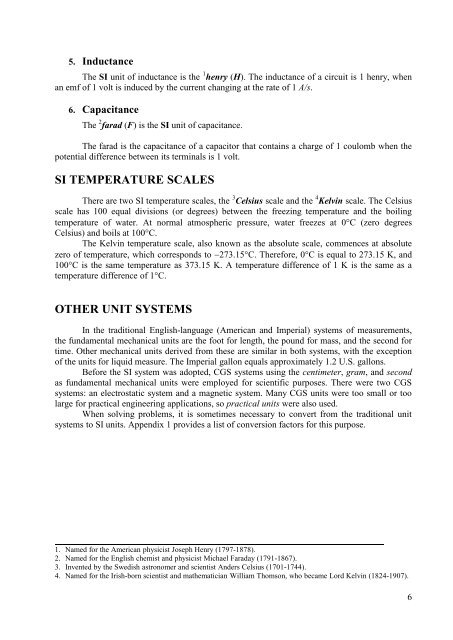Units, Dimensions, and Standards INTRODUCTION
Units, Dimensions, and Standards INTRODUCTION
Units, Dimensions, and Standards INTRODUCTION
Create successful ePaper yourself
Turn your PDF publications into a flip-book with our unique Google optimized e-Paper software.
5. InductanceThe SI unit of inductance is the 1 henry (H). The inductance of a circuit is 1 henry, whenan emf of 1 volt is induced by the current changing at the rate of 1 A/s.6. CapacitanceThe 2 farad (F) is the SI unit of capacitance.The farad is the capacitance of a capacitor that contains a charge of 1 coulomb when thepotential difference between its terminals is 1 volt.SI TEMPERATURE SCALESThere are two SI temperature scales, the 3 Celsius scale <strong>and</strong> the 4 Kelvin scale. The Celsiusscale has 100 equal divisions (or degrees) between the freezing temperature <strong>and</strong> the boilingtemperature of water. At normal atmospheric pressure, water freezes at 0C (zero degreesCelsius) <strong>and</strong> boils at 100°C.The Kelvin temperature scale, also known as the absolute scale, commences at absolutezero of temperature, which corresponds to 273.15°C. Therefore, 0°C is equal to 273.15 K, <strong>and</strong>100°C is the same temperature as 373.15 K. A temperature difference of 1 K is the same as atemperature difference of 1°C.OTHER UNIT SYSTEMSIn the traditional English-language (American <strong>and</strong> Imperial) systems of measurements,the fundamental mechanical units are the foot for length, the pound for mass, <strong>and</strong> the second fortime. Other mechanical units derived from these are similar in both systems, with the exceptionof the units for liquid measure. The Imperial gallon equals approximately 1.2 U.S. gallons.Before the SI system was adopted, CGS systems using the centimeter, gram, <strong>and</strong> secondas fundamental mechanical units were employed for scientific purposes. There were two CGSsystems: an electrostatic system <strong>and</strong> a magnetic system. Many CGS units were too small or toolarge for practical engineering applications, so practical units were also used.When solving problems, it is sometimes necessary to convert from the traditional unitsystems to SI units. Appendix 1 provides a list of conversion factors for this purpose.1. Named for the American physicist Joseph Henry (1797-1878).2. Named for the English chemist <strong>and</strong> physicist Michael Faraday (1791-1867).3. Invented by the Swedish astronomer <strong>and</strong> scientist Anders Celsius (1701-1744).4. Named for the Irish-born scientist <strong>and</strong> mathematician William Thomson, who became Lord Kelvin (1824-1907).6
















